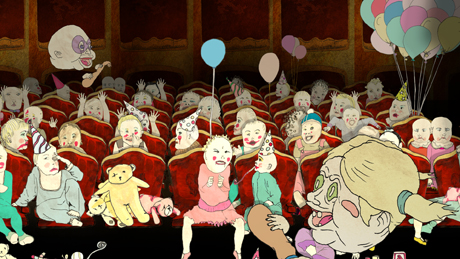A Liar’s Autobiography – always look on the animated side of life

Surreal: A Liar's Autobiography
A Liar’s Autobiography: The Untrue Story of Monty Python’s Graham Chapman is a long but fitting title for this 3D animated adaptation of Chapman’s absurdist autobiography.
The film is an impressionistic journey through Chapman’s troubled life and reflections, narrated by the Monty Python man himself in a recording made shortly before his death in 1989.
Fourteen animation companies have created vignettes of recollections from his life, which include his childhood during the Second World War as well as his struggles with alcoholism and coming out as a gay man.
Perhaps the darkest and most introspective foray into such weighty themes is the nightmare scene, dreamed up and created by Hackney-based mixed media design company, Tundra.
Tundra was born in a rented bedroom in Shoreditch in 2002, set up by four visual artists who made Hackney their home when the area was “really open to creatives” in terms of space and affordability, according to Tundra’s Espen Haslene.
In an environment that welcomed open creativity, Tundra evolved through word of mouth, making a name for itself with its solutions using a variety of techniques, including illustration, photography and animation. “We tend to mix media,” says Espen, “to create a whole new world for whatever we need to do.”
A Liar’s Autobiography was the first project of its kind for the company, which was short listed out of a potential 200 companies for the project.
“It was a mad project to be involved in. We had so many technical issues because we had to produce it in stereoscopic 3D and no one had ever done that before with that sort of style, it was quite daunting and took a lot of working out,” says Espen. “We drew it all, frame by frame, and then painted the illustrations, some on Photoshop, some by hand, and layered them up.”
The interpretation of the abstract scene was Tundra’s own dark creation. “We wanted people to recognise the sketch and at the same time add something different to it,” explains Espen.
The scene begins with Graham in a boxing ring where he is his own opponent, playing to a baying crowd before ripping himself open in a gory literalisation of self-destruction. The audience goes wild. He catapults himself into a pile of limbs far away, where a psychologist lectures him on alcoholism. But the psychologist is a bird with the voice of Monty Python’s Terry Gilliam. “It’s really the inner voice in his book, more like him talking to himself,” Espen explains.
The gore continues with Chapman’s liver dripping blood onto his own head which then bursts open into a mass of pills. He then tumbles into a cardboard theatre to be met by an audience of ghoulish babies who sing a song about putting his limbs back together.
“It’s like he’s fighting his own inner demons,” continues Espen. “Once you know a bit about Graham – his struggles, how he lived his life – [you realise] he was quite a unique person, not a straightforward nine to five guy. I found it really challenging, working out how to represent his struggles with both sexuality and alcoholism, the idea of him being the top guy but not feeling it, always having to put on his face.”
A Liar’s Autobiography premiered at this year’s BFI London Film Festival and will be on general release in full stereoscopic 3D in January 2013.
